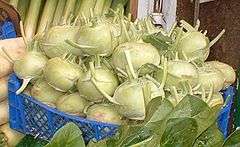Kohlrabi
| Kohlrabi | |
|---|---|
 Kohlrabi stem with leaves | |
| Species | Brassica oleracea |
| Cultivar group | Gongylodes Group |
| Cultivar group members | many; see text |
| Nutritional value per 100 g (3.5 oz) | |
|---|---|
| Energy | 113 kJ (27 kcal) |
|
6.2 g | |
| Sugars | 2.6 g |
| Dietary fiber | 3.6 g |
|
0.1 g | |
|
1.7 g | |
| Vitamins | |
| Vitamin A equiv. |
(0%) 2 μg |
| Thiamine (B1) |
(4%) 0.05 mg |
| Riboflavin (B2) |
(2%) 0.02 mg |
| Niacin (B3) |
(3%) 0.4 mg |
| Pantothenic acid (B5) |
(3%) 0.165 mg |
| Vitamin B6 |
(12%) 0.15 mg |
| Folate (B9) |
(4%) 16 μg |
| Vitamin B12 |
(0%) 0 μg |
| Vitamin C |
(75%) 62 mg |
| Vitamin D |
(0%) 0 μg |
| Vitamin E |
(3%) 0.48 mg |
| Vitamin K |
(0%) 0.1 μg |
| Minerals | |
| Calcium |
(2%) 24 mg |
| Iron |
(3%) 0.4 mg |
| Magnesium |
(5%) 19 mg |
| Manganese |
(7%) 0.139 mg |
| Phosphorus |
(7%) 46 mg |
| Potassium |
(7%) 350 mg |
| Sodium |
(1%) 20 mg |
| Other constituents | |
| Water | 91.00 g |
|
| |
| |
|
Percentages are roughly approximated using US recommendations for adults. Source: USDA Nutrient Database | |
Kohlrabi (German turnip or turnip cabbage; Brassica oleracea Gongylodes Group) is an annual vegetable, and is a low, stout cultivar of cabbage. Kohlrabi can be eaten raw as well as cooked. Edible preparations are made with both the stem and the leaves.
Etymology
The name comes from the German Kohl ("cabbage") plus Rübe ~ Rabi (Swiss German variant) ("turnip"), because the swollen stem resembles the latter.[1] Kohlrabi is a commonly eaten vegetable in German-speaking countries, but is also very popular in the northern part of Vietnam where it is called su hao, and in eastern parts of India (West Bengal) and Bangladesh where it is called Ol Kopi. It is also found in the Kashmir valley in north India and is there known as Monj-hakh, monj being the round part, and hakh being the leafy part.
Description
Kohlrabi has been created by artificial selection for lateral meristem growth (a swollen, nearly spherical shape); its origin in nature is the same as that of cabbage, broccoli, cauliflower, kale, collard greens, and Brussels sprouts: they are all bred from, and are the same species as, the wild cabbage plant (Brassica oleracea).
The taste and texture of kohlrabi are similar to those of a broccoli stem or cabbage heart, but milder and sweeter, with a higher ratio of flesh to skin. The young stem in particular can be as crisp and juicy as an apple, although much less sweet.[2]

Except for the Gigante cultivar, spring-grown kohlrabi much over 5 cm in size tend to be woody, as do full-grown kohlrabi much over perhaps 10 cm in size; the Gigante cultivar can achieve great size while remaining of good eating quality.[3] The plant matures in 55–60 days after sowing and has good standing ability for up to 30 days after maturity. The approximate weight is 150 g.
There are several varieties commonly available, including White Vienna, Purple Vienna, Grand Duke, Gigante (also known as "Superschmelz"), Purple Danube, and White Danube. Coloration of the purple types is superficial: the edible parts are all pale yellow. The leafy greens can also be eaten. One commonly used variety grows without a swollen stem, having just leaves and a very thin stem, and is called Haakh. Haakh and Monj are popular Kashmiri dishes made using this vegetable.

In the second year, the plant will bloom and develop seeds.

Preparation and use
Kohlrabi stems are surrounded by two distinct fibrous layers that do not soften appreciably when cooked. These layers are generally peeled away prior to cooking or serving raw, with the result that the stems often provide a smaller amount of food than one might assume from their intact appearance.
The kohlrabi root is frequently used raw in salad or slaws. It has a texture similar to that of a broccoli stem, but with a flavor that is sweeter and less vegetal.
Kohlrabi leaves are edible and can be used interchangeably with collard greens and kale.
Kohlrabi is an important part of the Kashmiri diet and one of the most commonly cooked foods. It is prepared with its leaves and served with a light gravy and eaten with rice.
Some varieties are grown as feed for cattle.[4]
References
- ↑ "Vegetable Dictionary - Kohlrabi". extension.illinois.edu. Retrieved 2016-05-09.
- ↑ "Kohlrabi Is Weird! And Here's What You Can Do With It — Ingredient Spotlight". The Kitchn. Retrieved 2016-05-09.
- ↑ "Growing Kohlrabi - Bonnie Plants". Bonnie Plants. Retrieved 2016-05-09.
- ↑ Bailey, L. H., (1912, republished in 1975). Kohlrabi for stock-feeding. In Cyclopedia of American Agriculture: Vol. II--crops. Macmillan Publishing, New York. p. 389-390. ISBN 0-405-06762-3. Google Book Search. Retrieved on June 15, 2008.
External links
| Wikimedia Commons has media related to Brassica oleracea var. gongylodes. |
- PROTAbase on Brassica oleracea (kohlrabi)
- Horticultural information on the tasty kohlrabi From the Learn2Grow databases
- Kohlrabi and Brussels Sprouts Are European
 Texts on Wikisource:
Texts on Wikisource:
- "Kohl-rabi". Encyclopedia Americana. 1920.
- "Kohl-rabi". New International Encyclopedia. 1905.
